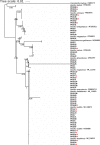Bioprospecting desert plant Bacillus endophytic strains for their potential to enhance plant stress tolerance
- PMID: 31796881
- PMCID: PMC6890672
- DOI: 10.1038/s41598-019-54685-y
Bioprospecting desert plant Bacillus endophytic strains for their potential to enhance plant stress tolerance
Erratum in
-
Author Correction: Bioprospecting desert plant Bacillus endophytic strains for their potential to enhance plant stress tolerance.Sci Rep. 2020 Feb 14;10(1):3001. doi: 10.1038/s41598-020-58957-w. Sci Rep. 2020. PMID: 32060294 Free PMC article.
Abstract
Plant growth-promoting bacteria (PGPB) are known to increase plant tolerance to several abiotic stresses, specifically those from dry and salty environments. In this study, we examined the endophyte bacterial community of five plant species growing in the Thar desert of Pakistan. Among a total of 368 culturable isolates, 58 Bacillus strains were identified from which the 16 most divergent strains were characterized for salt and heat stress resilience as well as antimicrobial and plant growth-promoting (PGP) activities. When the 16 Bacillus strains were tested on the non-host plant Arabidopsis thaliana, B. cereus PK6-15, B. subtilis PK5-26 and B. circulans PK3-109 significantly enhanced plant growth under salt stress conditions, doubling fresh weight levels when compared to uninoculated plants. B. circulans PK3-15 and PK3-109 did not promote plant growth under normal conditions, but increased plant fresh weight by more than 50% when compared to uninoculated plants under salt stress conditions, suggesting that these salt tolerant Bacillus strains exhibit PGP traits only in the presence of salt. Our data indicate that the collection of 58 plant endophytic Bacillus strains represents an important genomic resource to decipher plant growth promotion at the molecular level.
Conflict of interest statement
V.B.B. is on the Editorial Board of Scientific Reports. A.B., M.E., F.F.L., C.A.B., R.J., S.A., R.R., H.A., K.H.S., S.S., H.H. and M.M.S. declare that they have no competing interests.
Figures




References
-
- Zamioudis C, Pieterse CM. Modulation of host immunity by beneficial microbes. Molecular Plant-Microbe Interactions. 2012;25:139–150. - PubMed
Publication types
LinkOut - more resources
Full Text Sources
Miscellaneous

